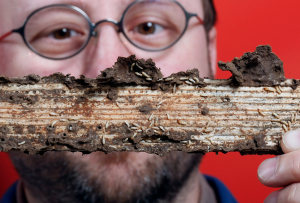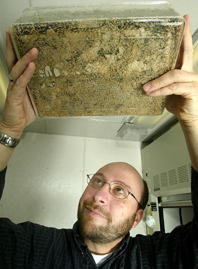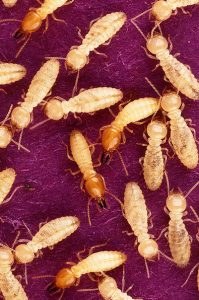

An unwanted house pest and suburban scourge, suddenly the termite has been accidentally and disasterously rehabilitated by science. Hyperbole? Termite control professionals don't think so.
Mike Scharf, Purdue's O.Wayne Rollins/Orkin Chair (yes, the pest-control Orkin) reported (press release) that his lab had discovered a cocktail of enzymes in termite guts that overcome the barriers to separating out sugars contained in biomass. The primary barrier: lignin. Function: strengthening plant cell walls and standing rigidly between science and cheaper fuel. This story has virally exploded across the geekier precincts of the internet, and almost overnight in many reader's imaginations, termites are now allies in the fight to kick fossil fuels. This is one of the strangest species odd-couplings of all time. Some professional exterminators privately grumble that Scharf's pairing is even worse: he's the Silence of the Lambs' Clarice Starling of pest control. (Insert slurping, flicking tongue here.)
Meanwhile, a Who's Who of green-energy venture capitalists have been making their way to the Purdue campus to personally witness the results.
This tale of scientific discovery should have ended differently. Early in his career, Scharf worked hard to uncover and exploit termite weaknesses. The goal: destroying colonies and saving the nation's homeowners the grief of millions of dollars in repairs. As a campus legend, for many years his lab lights were on when colleagues left the science building at night and still faintly visible at dawn. In 2003, a press release tried to sum up the goal:

Learning the molecular processes that cause termite larvae to grow into workers, soldiers or reproductive adults may lead to new methods to decimate colonies of the wood-eaters...
The word "decimate" certainly summed up the goal and "wood-eaters" has become a war cry in pest control. The entire industry was confident that someday Scharf would deliver the "golden bullet" that every Orkin man dreams about after a tough day in the trenches. The picture on the right was hung in Orkin franchises and waved on placards at Orkin conventions-- celebrating his confident, cocky, can-do spirit.
When Dr. Scharf became Purdue's first Rollins/Okin Chair in 2010, Steve Yaninek, head of the entomology department, said in a press release, "Dr. Scharf's accomplishments represent the complete package as a scholar who works on cutting-edge questions to address real-world problems. He is an envoy the pest management industry knows and trusts."
Gary W. Rollins, chief executive of Rollins Inc, which owns Orkin, also said, "Dr. Scharf's... expertise will be very valuable in developing technologies to safeguard public health." He was a pest control visionary, the university's Orkin man, lab coat and safety goggles his uniform. Orkin's philosophy was in synch with Scharf's, and via TV, relentlessly beamed to employees and the public:
Catchy, cocky, can do. How did it all go so wrong? Unintended consequences--and a conscientious scientist who enjoyed never knowing where the pursuit of knowledge might lead. Dr. Scharf, who just published his findings in the online journal PLoS One, has become the first researcher to measure sugar output from enzymes created by the termites themselves and from symbionts, the small protozoa that live in termite guts, aiding voracious digestive wood-eating.
Transferring a synthetic enzyme-fed virus to caterpillars
Mike Scharf is undeterred and explained his findings: "For the most part, people have overlooked the host termite as a source of enzymes

that could be used in the production of biofuels. For a long time it was thought that the symbionts were solely responsible for digestion," Scharf said in the press release. "Certainly the symbionts do a lot, but what we've shown is that the host produces enzymes that work in synergy with the enzymes produced by those symbionts. When you combine the functions of the host enzymes with the symbionts, it's like one plus one equals four."
Scharf and his research partners separated the termite guts, testing portions that did and did not contain symbionts on sawdust to measure the sugars created.
Once the enzymes were identified, Scharf and his team worked with Chesapeake Perl, a protein production company in Maryland, to create synthetic versions. The genes responsible for creating the enzymes were inserted into a virus and fed to caterpillars, which then produce large amounts of the enzymes. Tests showed that the synthetic versions of the host termite enzymes also were very effective at releasing sugar from the biomass.
Breaking the lignin barrier
They found that the three synthetic enzymes function on different parts of the biomass.
Two enzymes are responsible for the release of glucose and pentose, two different sugars. The other enzyme breaks down lignin, the rigid compound that makes up plant cell walls. Scharf said it's possible that the enzymes derived from termites and their symbionts, as well as synthetic versions, could be more effective at removing that lignin barrier.
Next, Scharf said his lab and collaborators will work identifying symbiont enzymes that could be combined with termite enzymes to release the greatest amount of sugars from woody material. This would increase the amount of biofuel that should be available from biomass.



Comments
Hi Harrington and thanks for a good article. Personally, I am have no clue about enzymes but the though of using Termites as Bio fuels makes me smile. I had to deal with a termite invasion a few years back and it was ugly, it did cost us a fortune and now we pay vast sums for termite insurance just to be sure. If there will ever be a secure way to protect against them you can count me in on that one. Anyway, sorry or the ramble and thanks again for the article. Best, William.